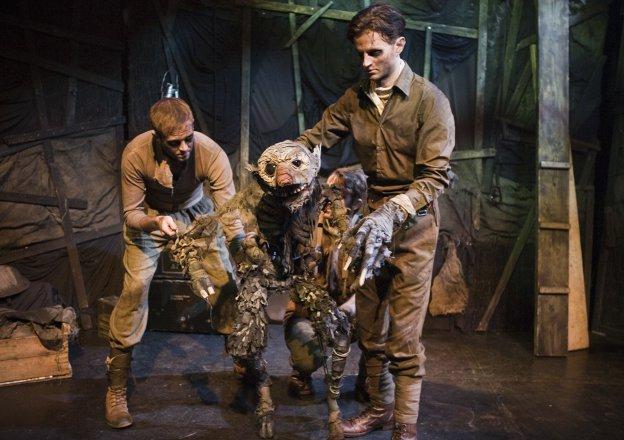Firm festival favourites Les Enfants Terribles have returned to the Fringe this year with The Trench, the story of a man trapped underground in a collapsed tunnel beneath the battlefields of France during World War One. We follow him as he encounters demons buried in the mud and comes to terms with the loss of his wife and infant child back home.
High hopes abounded as I sat down for this production, as I’d seen some great work from the company in the past. But unfourtunately, while the individual elements that make up the show are very good, I was left with an unshakeable feeling that these parts never came together to form a satisfying whole.
The script, written by Oliver Lansley, is dense, almost Shakesperean in its language, the lines reflecting the familiar poetic structure with the odd ‘doth’ thrown in for good measure. The complexity of the language is to be relished in the first ten minutes, but as the piece goes on it begins to feel too heavy. The density of the text and the sheer amount of words begin to hamper the piece, and I found myself longing for silence to allow space to digest the images and to place some of my own interpretation on the action. The method of delivery also becomes very grating as everything is delivered in a strained shout with little to no variation in tone. The cast of four on stage never once crack a smile. Of course, given the subject matter, there perhaps should not be a lot of humour, but the relentlessly serious tone became numbing with no lighter moments to contrast the dark.
The music by Alexander Wolfe is of a very high quality, but feels strangely segregated. The solo singer and guitarist is relegated to the side of the stage and songs are placed in between scenes. The effect has the feeling of an open mike night that is happening in the corner, playing sad songs over characters moving around on stage. The moments when the music serves the scene are most effective – most notably the use of a bow upon a metal cage to provide a haunting underscore whenever the horrors of war enter the piece in the form of macabre puppets.
The greatest strength of the piece is the design, and the puppets are truly breathtaking. The full-bodied puppets, operated by two or more of the cast, vary from hoofed demons to a particularly excellent representation of a World War One gas attack constructed of a large grotesque skull and great sheets that fill the stage. These demons fufil the task of embodying the horrors of war very well; they look like a convergence of Tim Burton’s The Nightmare Before Christmas, Jim Henson’s Dark Crystal and Brian Froud’s illustrations of goblins and fairies. Designer Sam Wyer has excelled himself in the sheer striking visual presence they have on stage and they are worth the ticket price alone. However, the method in which they are performed is purely presentational; they enter and stand there and talk, then exit. With the magic of puppetry coming from movement, it feels like a real waste of such excellently crafted creations. They feel suffocated under the words, brought on stage to serve the script with little to no consideration given to their characters or to their potential manipulation. Consequently they serve only to paint a (very striking) picture, and provide no magic that might elevate the scenes beyond their functional nature.
There are some excellent visual moments that stick in the mind, but the weaknesses of the individual parts of the piece detract from the whole, which meant that by the time we reached the heroic climax the outcome felt dimmed. With half the dialogue and more care taken in the construction and execution this piece could be awe-inspiring. But as it was, it felt like a show that never really found its feet. Certainly entertaining, but ultimately unsatisfying.


